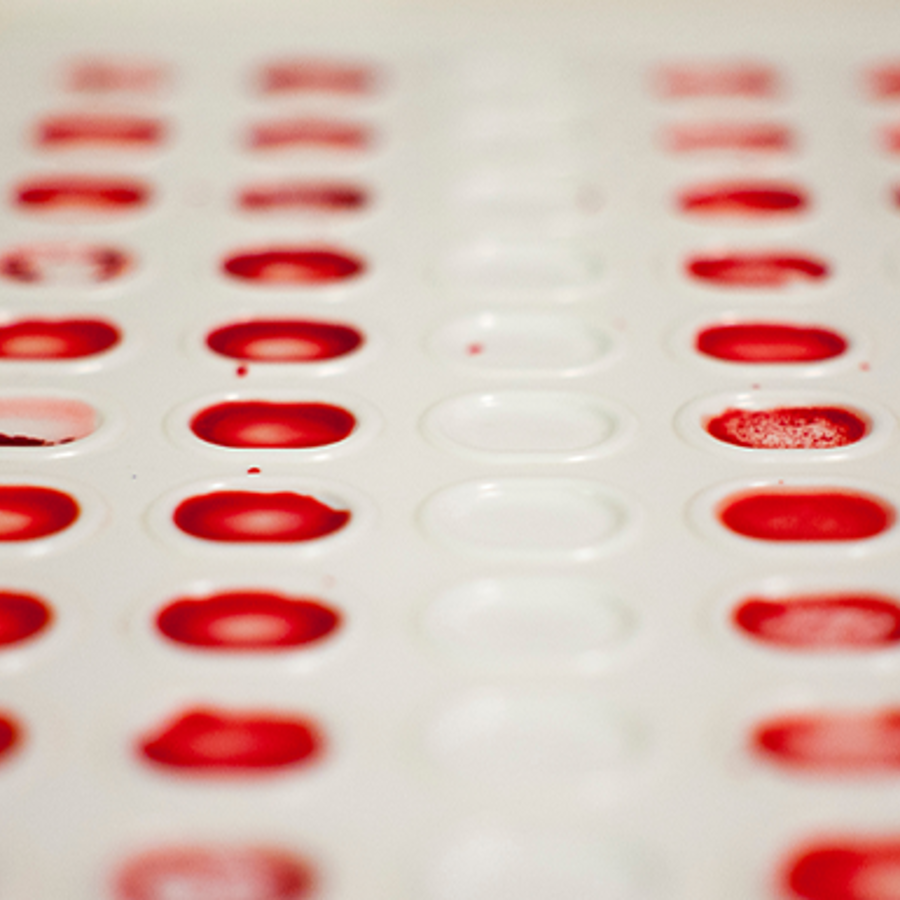
Is it possible for Rh- to disappear from a family’s lineage?
October 19, 2011

- Related Topics:
- Dominant and recessive,
- Rh factor,
- Blood type,
- Carrier
A curious adult from Canada asks:
"If people with Rh- in their extended family keep marrying into strong Rh bloodlines, is it possible to wipe out the Rh- out of a bloodline completely? So much so that eventually the Rh- won’t be able to recur in their offspring?"
It is possible to eliminate a trait like the Rh- blood type from a family's genes. But it won't necessarily last forever.
If someone in that family went on to have kids with someone who had Rh- in their genes, then they could have grandchildren with an Rh- blood type. Due to the basis of inheritance of traits like Rh-, it would be difficult to “filter out” the Rh- gene from a family’s genetics.
It also is not a sure thing that having children with people who have long Rh+ family histories will eliminate Rh- from your family's genes. There are plenty of scenarios where Rh- can hang out in a family tree for hundreds of years, waiting for the right time to reappear.
And there are scenarios where it is eliminated in just two generations. It is all really a matter of chance.
What I want to do for the rest of the answer is go into a little more detail about how Rh blood type works. Then I'll go through a few scenarios where Rh- disappears and then reappears later. As you’ll see, a recessive trait like Rh- blood is difficult to lose.
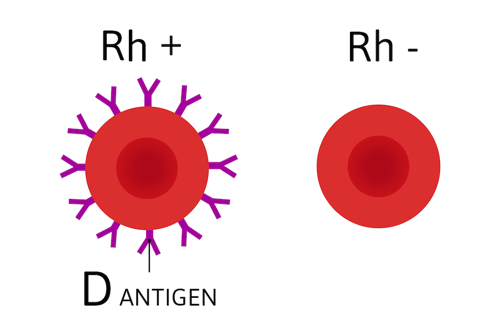
Rh Blood Type is Due to a Single Gene
Being Rh+ or Rh- has to do with the RhD gene. We can think of this gene as coming in two versions, RhD+ and RhD-.
As you may already know, we have two copies of each of our genes – one from each of our parents. The RhD gene is no exception.
So everyone has one of the three possible combinations of RhD genes outlined below:
|
Gene combination |
Blood type |
|
RhD+/RhD+ |
Rh+ |
|
RhD+/RhD- |
Rh+ |
|
RhD-/RhD- |
Rh- |
As you can see, if you have one or two copies of RhD+, then you have Rh+ blood. To end up with Rh- blood, you need to have two copies of RhD-.
In genetics lingo, RhD+ is dominant over RhD- (or RhD- is recessive to RhD+). In other words, all it takes to be Rh+ is to have one copy of your RhD gene be of the RhD+ variety. This means that even if you are Rh+, you could be hiding an RhD- copy in your genes.
A short game of chance
Imagine that we have the couple pictured below where one parent is Rh- and the other is Rh+:

For this example, we'll say the Rh+ parent has two copies of the RhD+ gene.
As you can see below, these two will have all Rh+ kids. It looks like the Rh- blood type has disappeared in a single generation. A closer look, though, shows that RhD- is still hidden in their kids' genes.
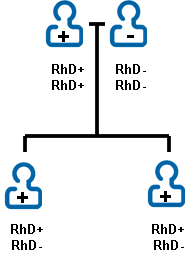
Each child has one RhD+ copy of the RhD gene and one RhD- copy. This means they are carriers of Rh- and so could still have Rh- kids.
As I show below, these kids need to go through one more generation to eliminate the Rh- completely.
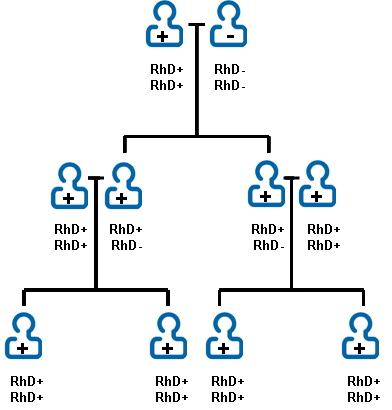
All the kids now have two copies of the RhD+ version of the RhD gene. The Rh- blood type is gone from the family.
Now it didn't have to turn out this way. For each child in that second generation, there was a 50% chance that they would get an RhD+ version and a 50% chance they would get an RhD- version. The probability of all four kids inheriting the RhD+ version (like I drew above) was only 1 in 16 chance.
Lingering Rh-
OK, let’s start out with our same couple and the same first generation of kids. As you can see, all the kids are still carriers.
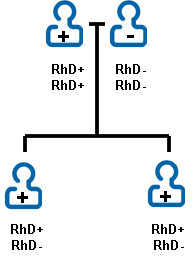
Now they again have kids with folks with two copies of the RhD+ version of the RhD gene. But this time, two of the four kids get an RhD- copy and so stay carriers. As you can see below, this can go on for many, many generations. Possibly forever!
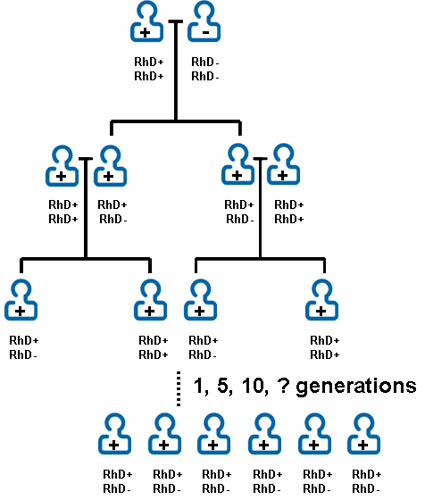
Even though this family keeps having kids with Rh+ partners, the RhD- version of the gene keeps hanging around.
And because they can’t shake it, a relative in the future may have Rh- blood. The most likely way for this to happen is if one of them has kids with another carrier.
Welcome Back Rh-
Let's start out this time with one of our carriers as shown below:

It could be ten or more generations since anyone has had Rh- blood in his family. But the RhD- version of the RhD gene is still there.
Now imagine that this person has children with another carrier. Their partner may not have had Rh- blood in their family's living memory either. But again, the RhD- version is still there.
These two have kids with the following results:
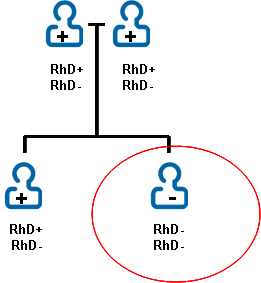
As you can see, they had an Rh- child! Given their genes, each child had a 1 in 4 chance of getting an RhD- copy from each parent and so ending up with Rh- blood. The child beat the odds and Rh- is back.
As a final step, let's go back to our first example. Remember, all the kids had only RhD+ copies of the RhD gene. There was no RhD- in their blood.
Below you can see that if one of them has children with a carrier, then after just two generations it is possible for Rh- blood to reappear.
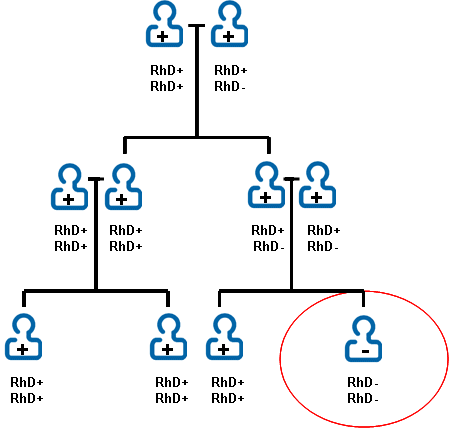
So, as you can see, it can be difficult for a recessive trait like Rh- to become completely obsolete in a family. This is true even when the trait has been absent for quite some time.

Author: Dr. D. Barry Starr
Barry served as The Tech Geneticist from 2002-2018. He founded Ask-a-Geneticist, answered thousands of questions submitted by people from all around the world, and oversaw and edited all articles published during his tenure. AAG is part of the Stanford at The Tech program, which brings Stanford scientists to The Tech to answer questions for this site, as well as to run science activities with visitors at The Tech Interactive in downtown San Jose.
 Skip Navigation
Skip Navigation
